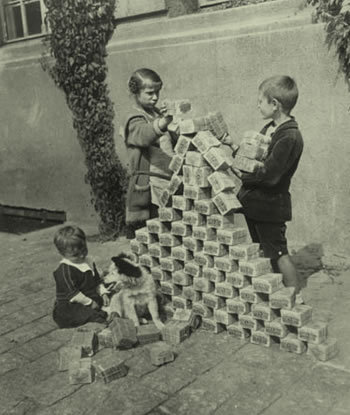Hyperinflation
In 1923 Germany experienced Hyperinflation. The value of money plummeted. Hyperinflation was caused by several things. Government policy was designed to force changes to the terms of the Treaty of Versailles. The economy was struggling. Confidence in banks and investments was low. Overseas trade was difficult. Combined, they created Hyperinflation, a situation in which money became virtually worthless.
Inflation is the term used to describe an increase in the cost of goods in an economy. Typically a rate of inflation will be between 2 and 6% over the course of a year. This means that if something costs £1 at the start of the year, it will cost £1.02 – £1.06 a year later. In general, it is accepted that relatively low levels of inflation are a good thing for an economy, however high levels of inflation pose problems as companies cannot accurately forecast their results and the value of money drops disproportionately to the value of goods and / or labour. Hyper inflation is a term used to describe levels of inflation that are very high. This was the case in Germany in the period 1919 – 1923.
In January 1919 one US Dollar could buy 8.9 German marks. In January 1922 one US Dollar could purchase 191.8 German marks. What does this mean?
This means that the buying power of the German mark (Germany’s currency) has dropped at an incredible rate. Something that cost one US dollar in 1919 would have cost 8.9 German marks. 3 years later it costs 191.8 German marks, but still is worth one US Dollar. This shows that the value of the German currency has dropped dramatically. Several things contributed to this devaluation of the German currency, which continued to decline in value throughout 1922 and 1923:
- The Reparations Bill. Having to pay the Allies large sums of money had a significant impact upon the German economy. It meant that a large proportion of income had to leave the country.
- Reaction to the Reparations Bill. In order to manage Reparations payments strict economic controls and fiscal (taxes) practices were required. It can be argued that the Government deliberately failed to put many of these things into place, in an attempt to force the Allies into rethinking the level of Reparations to be paid. The consequences of this include the following point:
- French occupation of the Ruhr. The Ruhr valley is the Industrial heart of Germany. Whilst it was occupied by the French, the German economy could not benefit from its industrial output, thus straining the economy even further.
- The cost of War. Even without the reparations, the war had a high cost for Germany.
- Loss of land and colonies. This led to the cost of raw materials increasing as the German economy could no longer depend upon cheap imports from her own colonies or produce the raw materials in the same quantities from German sources. The increase in the cost of raw materials was inflationary, it meant that prices would have to rise.
- Printing more money. In order to control inflation, a Government can limit the amount of currency in circulation. At the height of the reparations repayment crisis the Weimar Government did the exact opposite, it printed MORE money.
The scale of hyperinflation can be seen in this chart which illustrates the cost of items against an index. 1 is the starting point, anything above 1 is an increase in cost relative to that first figure (so 3 would mean that items had risen in price by 300%). NB: Usually an index would start with 100, the figures here are so large that the number of 0’s would simply become too onerous to type out!
Wholesale Price Index
|
July 1914
|
1.0
|
|
Jan 1919
|
2.6
|
|
July 1919
|
3.4
|
|
Jan 1920
|
12.6
|
|
Jan 1921
|
14.4
|
|
July 1921
|
14.3
|
|
Jan 1922
|
36.7
|
|
July 1922
|
100.6
|
|
Jan 1923
|
2,785
|
|
July 1923
|
194,000
|
|
Nov 1923
|
726,000,000,000
|
Source: http://www.usagold.com/GermanNightmare.html
Links
Impact of the First World War on Germany
Terms of the Treaty of Versailles
How did Germany recover from the economic crisis of 1923?
Teach the Hyperinflation Crisis. An Active Learning exercise designed to make the complexities of Hyperinflation understandable.
When Money Dies: Five currencies that crashed – excellent infographic based post that looks at five instances of hyperinflation.
[products limit=”8″ columns=”4″ category=”hitlers-germany” cat_operator=”AND”]


